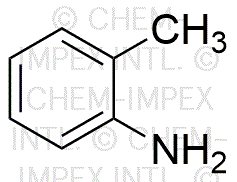2-Aminotoluene is widely utilized in research focused on:
- Dyes and Pigments: This compound serves as a key intermediate in the production of azo dyes, which are extensively used in textiles and inks, providing vibrant colors and excellent stability.
- Pharmaceuticals: It plays a significant role in synthesizing various pharmaceutical agents, contributing to the development of medications for treating conditions like allergies and infections.
- Polymer Industry: 2-Aminotoluene is used in the formulation of certain polymers and resins, enhancing their properties such as durability and resistance to chemicals.
- Analytical Chemistry: This compound is employed in analytical methods for detecting and quantifying other substances, aiding researchers in environmental and quality control studies.
- Agrochemicals: It is involved in the synthesis of herbicides and pesticides, helping to improve agricultural productivity while ensuring safety and effectiveness in pest management.
General Information
Properties
Safety and Regulations
Applications
2-Aminotoluene is widely utilized in research focused on:
- Dyes and Pigments: This compound serves as a key intermediate in the production of azo dyes, which are extensively used in textiles and inks, providing vibrant colors and excellent stability.
- Pharmaceuticals: It plays a significant role in synthesizing various pharmaceutical agents, contributing to the development of medications for treating conditions like allergies and infections.
- Polymer Industry: 2-Aminotoluene is used in the formulation of certain polymers and resins, enhancing their properties such as durability and resistance to chemicals.
- Analytical Chemistry: This compound is employed in analytical methods for detecting and quantifying other substances, aiding researchers in environmental and quality control studies.
- Agrochemicals: It is involved in the synthesis of herbicides and pesticides, helping to improve agricultural productivity while ensuring safety and effectiveness in pest management.
Documents
Safety Data Sheets (SDS)
The SDS provides comprehensive safety information on handling, storage, and disposal of the product.
Product Specification (PS)
The PS provides a comprehensive breakdown of the product’s properties, including chemical composition, physical state, purity, and storage requirements. It also details acceptable quality ranges and the product's intended applications.
Certificates of Analysis (COA)
Search for Certificates of Analysis (COA) by entering the products Lot Number. Lot and Batch Numbers can be found on a product’s label following the words ‘Lot’ or ‘Batch’.
*Catalog Number
*Lot Number
Certificates Of Origin (COO)
This COO confirms the country where the product was manufactured, and also details the materials and components used in it and whether it is derived from natural, synthetic, or other specific sources. This certificate may be required for customs, trade, and regulatory compliance.
*Catalog Number
*Lot Number
Safety Data Sheets (SDS)
The SDS provides comprehensive safety information on handling, storage, and disposal of the product.
DownloadProduct Specification (PS)
The PS provides a comprehensive breakdown of the product’s properties, including chemical composition, physical state, purity, and storage requirements. It also details acceptable quality ranges and the product's intended applications.
DownloadCertificates of Analysis (COA)
Search for Certificates of Analysis (COA) by entering the products Lot Number. Lot and Batch Numbers can be found on a product’s label following the words ‘Lot’ or ‘Batch’.
*Catalog Number
*Lot Number
Certificates Of Origin (COO)
This COO confirms the country where the product was manufactured, and also details the materials and components used in it and whether it is derived from natural, synthetic, or other specific sources. This certificate may be required for customs, trade, and regulatory compliance.


